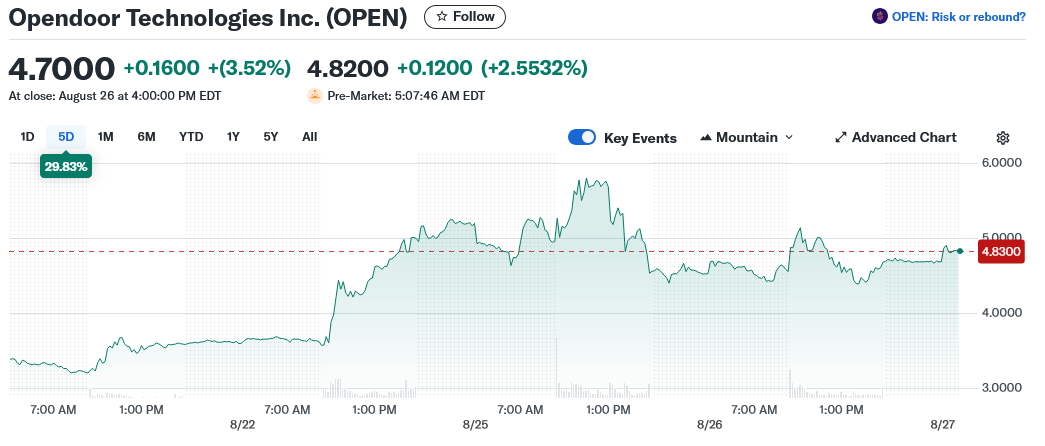TLDR
- Opendoor (OPEN) stock dropped 8.6% on Monday after rising over 15% earlier in the day following Fed Chair Powell’s rate cut hints
- Stock has surged nearly 300% since January, driven by meme stock momentum and AI integration promises
- Company reported Q2 revenue of $63 million and positive EBITDA of $6 million, beating expectations
- Business carries $2.2 billion in debt with razor-thin margins and operates at a loss with -3.9% operating margin
- Rate cuts could help refinance debt and boost housing demand, but uncertainty remains about timing and size of cuts
Opendoor Technologies stock dropped 8.6% by market close after climbing more than 15% earlier in the session.
The rollercoaster day reflects the ongoing uncertainty surrounding Federal Reserve policy. Fed Chair Jerome Powell’s Friday speech hinted at potential rate cuts in September, initially sparking enthusiasm among investors.
However, that excitement quickly faded as reality set in. The timing, size, and number of potential rate cuts remain unclear, leaving investors cautious about making big bets.

Meme Stock Status Fuels Triple-Digit Gains
Opendoor has become a standout performer this year, with shares climbing nearly 300% since January. The stock has gained attention as a meme stock, driven largely by retail trading momentum and online forum hype rather than fundamental improvements.
Short interest has remained elevated throughout the rally. This creates conditions for sharp price spikes when trading activity intensifies.
The company has also promoted its artificial intelligence initiatives as a growth driver. Management claims AI integration could improve pricing engines, marketing efforts, and in-home property assessments.
These AI improvements could potentially boost pricing accuracy and reduce operating costs. In a low-margin industry like real estate, such efficiencies matter.
The company also announced a CEO transition recently. Investors greeted this news positively, though the reasoning behind the change remains unclear.
Second-quarter results provided some support for the stock. Revenue came in at $63 million, beating projections. The company also posted positive EBITDA of $6 million, which exceeded expectations.
Financial Reality Tells Different Story
Despite the stock’s impressive run, the underlying business faces serious challenges. Revenue has declined at an average rate of 24% annually over the past three years.
The latest 12-month revenue figure stands at $5.2 billion, representing a 14% rebound. Quarter-over-quarter growth was more modest at 3.7%.
Operating losses persist across the business. The company reported negative $204 million in operating income over the last 12 months, translating to a -3.9% operating margin.
Debt levels remain concerning at $2.2 billion, primarily used to finance housing inventory. While this financing model is standard for instant-buying platforms, it creates risk given the thin margins.
The debt-to-equity ratio sits at 66% based on the current $3.3 billion market cap. Cash reserves of $789 million provide some financial cushion.
Rate cuts could help Opendoor refinance its debt at lower costs. Lower rates typically boost housing demand by reducing mortgage costs for consumers.
This increased activity could drive more transactions through Opendoor’s platform. However, the company remains highly sensitive to housing market cycles and interest rate fluctuations.
The stock trades at a price-to-sales multiple of 0.6x, appearing cheap compared to the S&P 500’s 3.3x ratio. This metric can be misleading since Opendoor books entire home sale prices as revenue rather than just the spread it earns.


